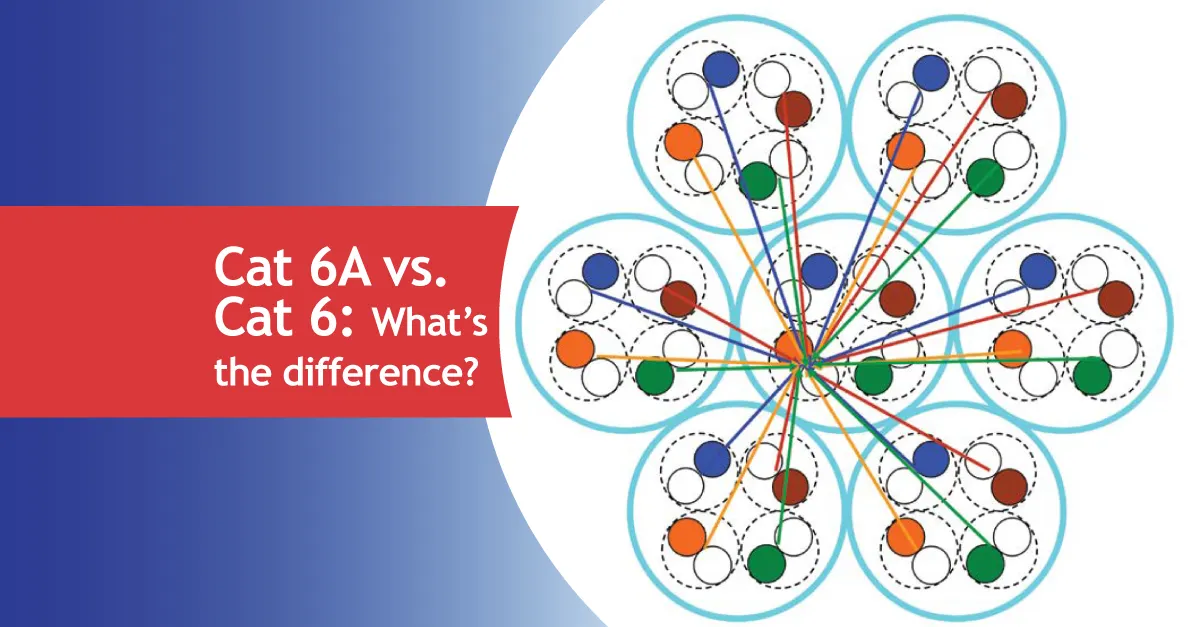The future of gigabit ethernet cabling is here.
Well… it’s actually been here since 2004. First appearing as SYSTIMAX® GigaSPEED X10D from CommScope®, the transition from 6 to 6A started in earnest years later, resulting in Cat 6A being the recommended cable modern networks are built with now.
Designed with the future in mind — power over ethernet (PoE) improvements, bandwidth upgrades, and distance for 10g transmission (more than double that of Cat 6) — Cat 6A represents something of a quantum leap. With innovation being the norm and user demands on a network consistently growing, Cat 6A is the best option to meet today’s challenges — and tomorrow’s.
“Future-proof” gets thrown around a lot. Plenty of things are called “must-haves” these days but, in a bandwidth-hungry world that’s constantly evolving, Cat 6A is as close as it gets to being just that.
It is the future-ready choice for enterprise-level networks.
Cat 6A vs. Cat 6: what’s the difference?
Let’s start with some concrete numbers:

In a nutshell, Cat 6A:
- Has vastly improved bandwidth, doubling that of Cat 6
- Offers 10g stretching to 100m compared to a mere 37m for Cat 6
It’s easy to see why global spending on Cat 6A is forecasted to outpace that of Cat 6 in the near future:

When it comes to new installations, it’s a no-brainer to start with Cat 6A.
Is it a bit pricier? Yes (but only a bit).
Are you setting yourself for an even higher cost to upgrade later? Perhaps, especially considering that a user’s internet bandwidth grows by 50% per year. Demands on networks, in terms of both speed and data transmission, never decrease.
Remember that cables will be among the longest-lived pieces of equipment in your network. So they’re not the place to compromise based on cost.
Ideal uses cases for Cat 6A:
As the world shifts, it’s clear that the demands we put on our digital infrastructure do too. More power, more speed, and more devices are required in seemingly infinite amounts in the Internet of Things era.
Cat 6A is made for higher performance and keeps you ready with applications, including everything you’re doing already.
- Streaming media, AV systems & digital signage
- Standard office applications
- IoT
- PoE and lighting
- Next-gen Wi-Fi 6/6E
- In-building cellular
- High-performance computing
- Multi-site collaboration
To home in on Wi-Fi specifically for a moment, with Wi-Fi 6/6E becoming the norm, any upgrade there will require a move to Cat 6 at a minimum.
There’s a reason 6A is the recommended cable for new installations in everything from healthcare and educational facilities to stadiums. Case in point, the Las Vegas Raiders’ new stadium has 284 miles of SYSTIMAX® Cat 6A cabling that connects more than 2,400 screens, displays and signs to create a second-to-none user experience.
Control crosstalk
A big issue with Cat 6 and its predecessors was the amount of crosstalk within the bundles, which created signal noise and performance issues. As per a recent white paper by CommScope: “Category 6A was to be the first cabling specification to specify repeatable alien crosstalk performance, while being specified to a frequency of 500 MHz, and have an insertion loss improved over Category 6 cabling to allow the network electronics to achieve their maximum performance.”
Get future-ready with a transition to Cat 6A.
On top of all the upgrades that Cat 6A represents, and how necessary those upgrades will be in the coming years, it’s important to point out that Cat 6A is backward compatible with the ever-familiar RJ45 interface.
In a world of more, ensure your network can meet and exceed demands. Who better to run with than the pioneer in the space: CommScope.
Additional resource:




